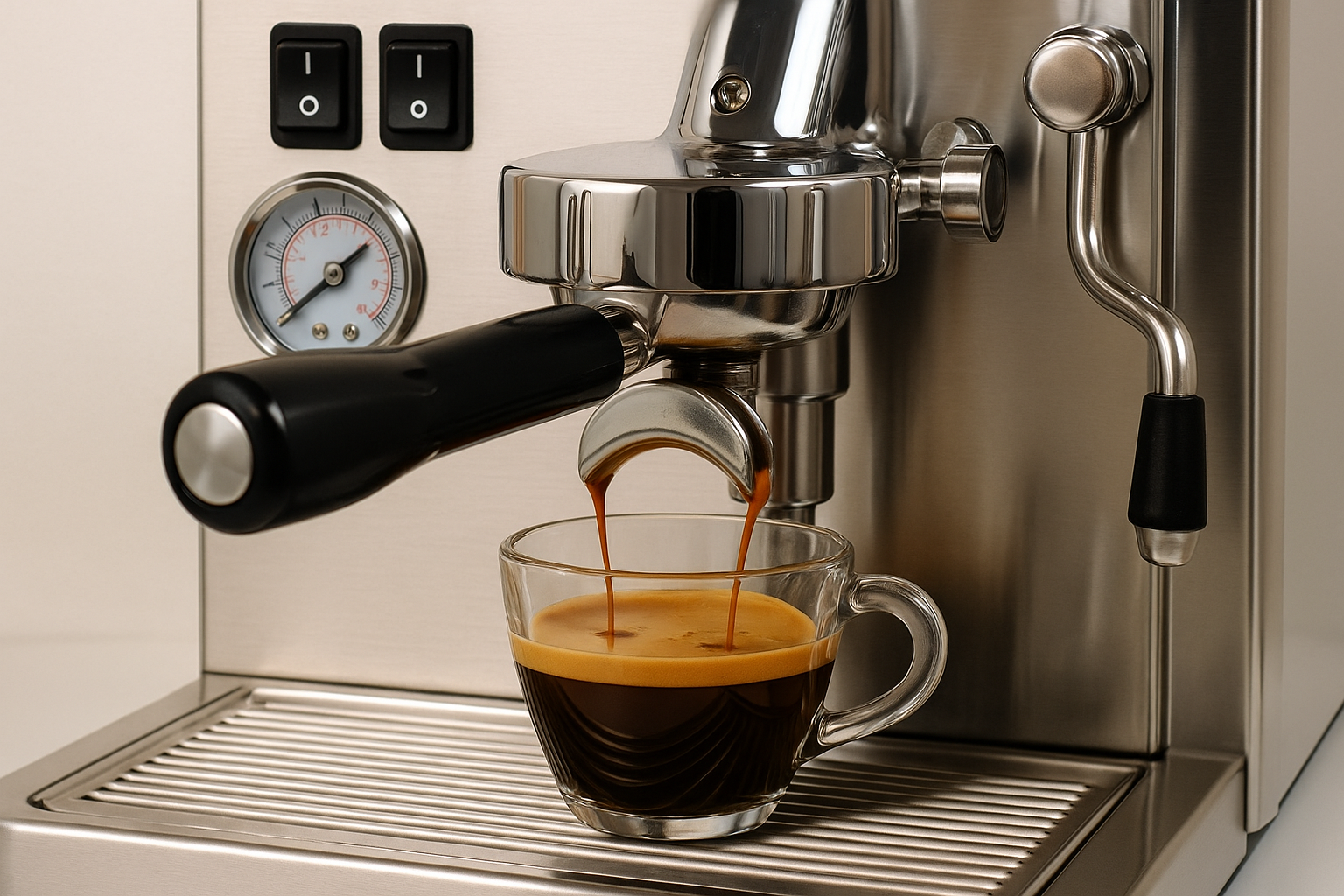Espresso is often viewed as the pinnacle of coffee brewing—rich, intense, and complex. Behind that small, concentrated shot lies an impressive interplay of engineering, chemistry, and precision mechanics.
Espresso machines may look simple from the outside, but internally, they’re built with carefully designed components to manipulate pressure, temperature, and time to extract the best flavors from finely ground coffee.
In this article, we’ll take a deep dive into the science and technology behind espresso machines, exploring how they work, what makes them unique, and how various design features affect the final shot.
What Is Espresso, Technically?
Espresso is not a type of coffee bean or roast; it’s a brewing method defined by its pressure-based extraction. True espresso is brewed by forcing hot water through finely ground coffee at high pressure, usually around 9 bars (or 130 psi), producing about 30 ml of coffee in 25 to 30 seconds.
This pressure creates the signature crema, the golden-brown foam that rests atop a well-pulled shot. The crema is a result of CO₂ emulsified with coffee oils and solids—an indicator of both freshness and technique.
Key Components of an Espresso Machine
Espresso machines vary in complexity, but all share a few essential components that make the process possible:
1. Boiler (or Heating Element)
The boiler is responsible for heating water to the correct brewing temperature—typically between 195°F to 205°F (90°C to 96°C). Some machines use a single boiler, while others have:
- Dual boilers: One for brewing, one for steaming milk simultaneously.
- Heat exchanger systems: Uses one boiler to perform both tasks via separate circuits.
Temperature stability is vital. A few degrees too hot or too cold can drastically affect flavor.
2. Pump
The pump is what creates pressure. Manual lever machines use human force, but most modern espresso machines use electric pumps. The most common type is the vibratory (vibe) pump, but rotary pumps (found in commercial-grade machines) offer more consistency and are quieter.
Pumps are calibrated to maintain 9 bars of pressure throughout extraction—a delicate balance requiring precision engineering.
3. Group Head
This is where the magic happens. The group head is the component where the water meets the coffee. It holds the portafilter in place and disperses hot water evenly across the coffee puck.
The E61 group head is a classic design used in many machines, known for its temperature stability and pre-infusion capabilities (more on that shortly).
4. Portafilter
The portafilter is the handle that holds the filter basket, which contains the coffee grounds. The size, shape, and material of the portafilter affect heat retention and shot consistency.
Baristas typically use 18–20 grams of coffee in a double-shot portafilter basket, though this can vary by machine and personal preference.
5. Pressure Gauge
Many machines include a pressure gauge to show the barista what’s happening during extraction. This allows real-time adjustments and is key for diagnosing problems like channeling or under-extraction.
The Science of Extraction
Espresso extraction is a complex chemical process that transforms solid coffee grounds into a liquid packed with soluble compounds, oils, and flavors. Here’s how it works, broken into phases:
1. Pre-Infusion
Pre-infusion involves wetting the coffee puck at a lower pressure (often 2–4 bars) before full pressure is applied. This allows the grounds to expand evenly and helps avoid channeling, where water finds a weak path and flows unevenly.
Machines with pre-infusion typically produce more balanced, flavorful shots.
2. Pressure Phase
At this point, the machine ramps up to 9 bars of pressure, forcing hot water through the compact coffee bed. Extraction lasts 25 to 30 seconds, during which the most desirable compounds are pulled out:
- Acids and aromas come first
- Sugars and oils follow
- Bitter compounds come last
A well-balanced shot ends extraction before too many bitter compounds develop.
3. Emulsification and Crema
One of espresso’s unique traits is crema, the foam layer formed by CO₂ trapped during roasting. The pressure forces it out of the coffee, where it binds with oils to create the golden surface layer.
Crema is often seen as a sign of quality, though it can be misleading—stale beans can still produce crema if roasted dark enough.
Variables That Affect Espresso Quality
Making great espresso is both an art and a science. Here are some of the main variables a machine helps regulate—or that the barista must control:
1. Pressure
Standard espresso machines aim for 9 bars, but some allow pressure profiling—where pressure changes throughout extraction. This can unlock more complexity in the cup, but requires experience to master.
2. Temperature
Stable water temperature is essential. Machines with PID (Proportional-Integral-Derivative) controllers offer precise temperature regulation, improving repeatability and consistency.
3. Grind Size
Espresso requires a very fine grind. If the grind is too coarse, water flows too fast, resulting in sour, weak coffee. Too fine, and it may choke the machine, leading to bitterness.
4. Dose and Tamping
The dose (amount of coffee in the basket) and tamping pressure (how firmly you press the grounds) affect resistance and extraction time. Consistency in tamping is key to achieving a repeatable shot.
5. Water Quality
Since espresso is 90–95% water, its composition matters. Ideally, it should be filtered, with balanced minerals—not distilled or overly hard. Many commercial machines include built-in water filtration systems.
Types of Espresso Machines
Manual (Lever) Machines
These require physical effort to create pressure and full control over extraction. They’re favored by purists but have a steep learning curve.
Semi-Automatic Machines
Most home espresso machines fall into this category. You control grind, tamp, and shot timing, while the machine regulates pressure and temperature.
Automatic Machines
These machines automate shot volume and sometimes grinding. Popular in offices and homes for their user-friendliness.
Super-Automatic Machines
These do everything—grind, dose, tamp, brew, and even steam milk. Best for convenience, but limited in customization.
Commercial Machines
Built for cafés, they feature dual boilers, rotary pumps, and multiple group heads, capable of handling high volume and maintaining consistency under pressure.
Innovations and Trends
Espresso machine technology continues to evolve. Some cutting-edge features include:
- Pressure profiling (changing pressure mid-extraction)
- Pre-set shot recipes
- Smart connectivity for data tracking
- Self-cleaning functions
- Thermoblock systems for faster warm-up
Many premium machines now allow complete customization—offering data-driven feedback on pressure curves, extraction yields, and temperature logs.
Final Thoughts: More Than Just a Machine
An espresso machine is much more than a fancy appliance—it’s a precision instrument that unlocks the depth of coffee through engineering and science. While modern machines have become more user-friendly, mastering espresso still requires understanding the interplay of pressure, grind, temperature, and time.
Whether you’re a home barista or a café professional, knowing how your espresso machine works not only improves your brews—it deepens your connection to the process and transforms every shot into a carefully crafted experience.

Marcelo Oliveira is a coffee enthusiast and content creator specializing in barista skills, brewing methods, equipment reviews, coffee-related health insights, and fascinating curiosities from the coffee world. With a deep passion for every step of the brewing process, he turns technical knowledge into accessible and engaging content for both beginners and seasoned coffee lovers. Marcelo’s goal is to help readers appreciate the full experience of coffee—from bean to cup.
